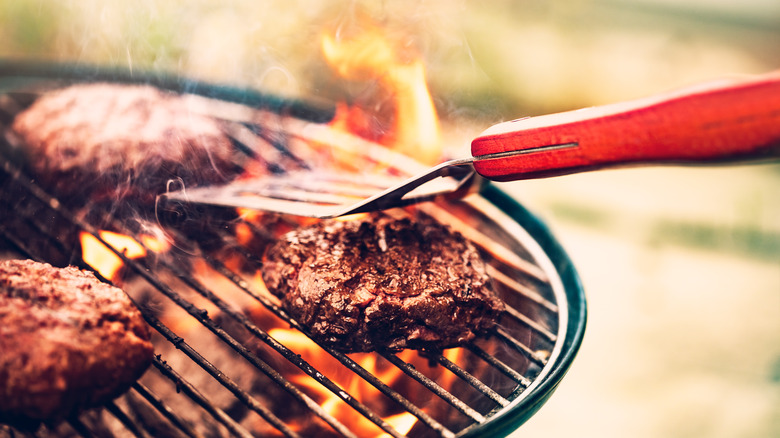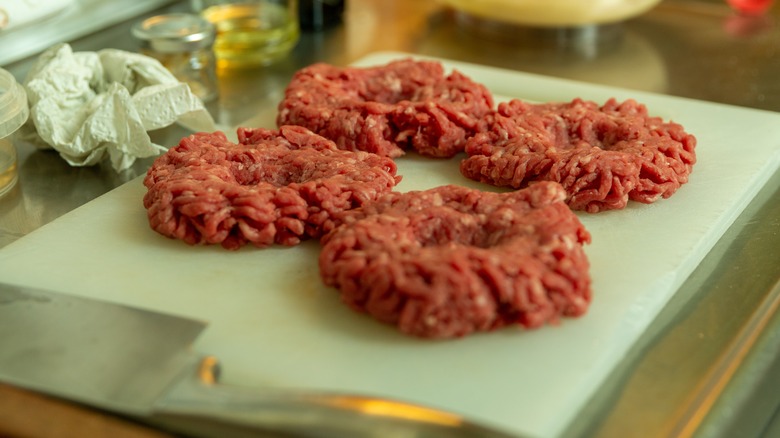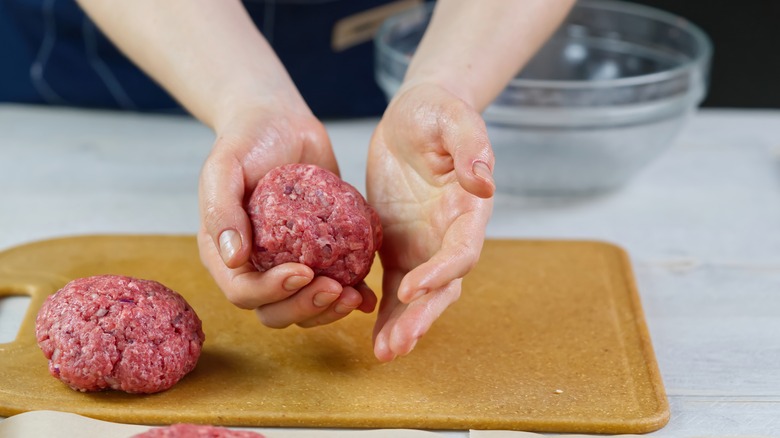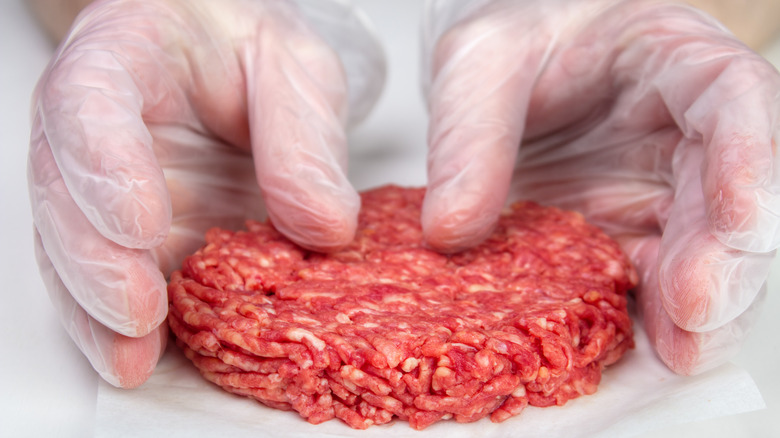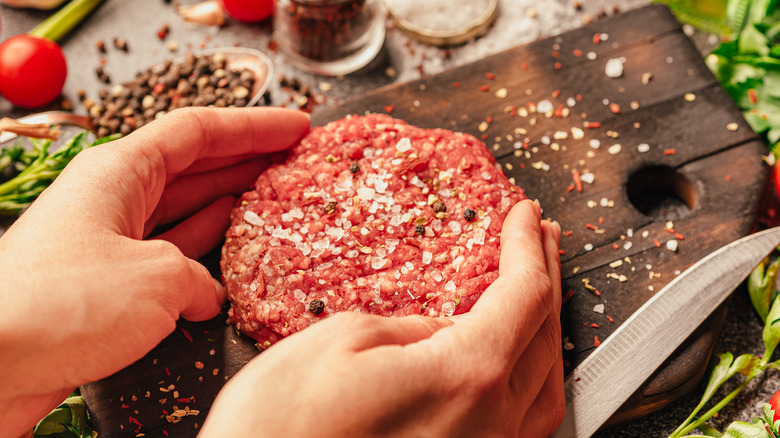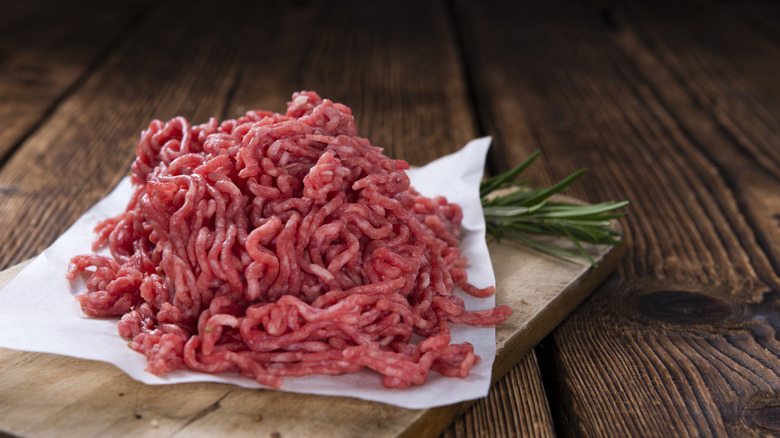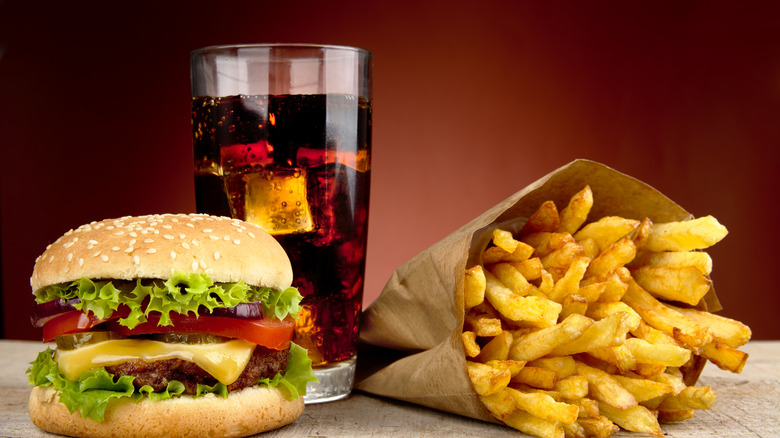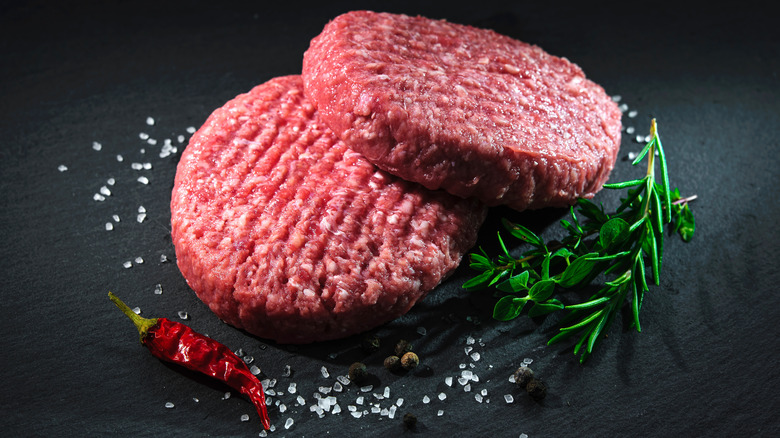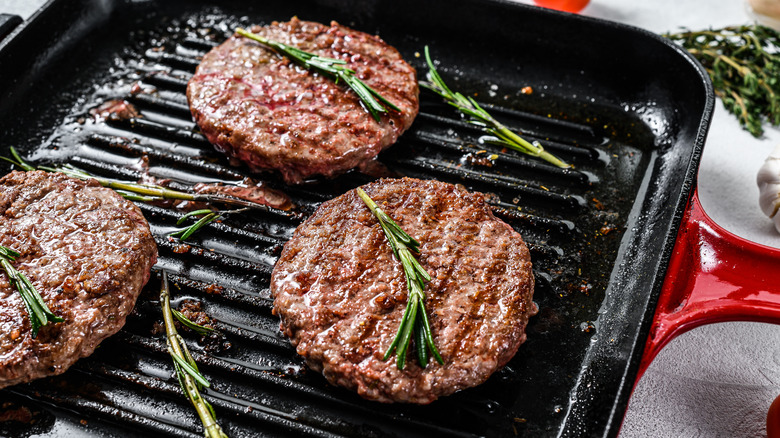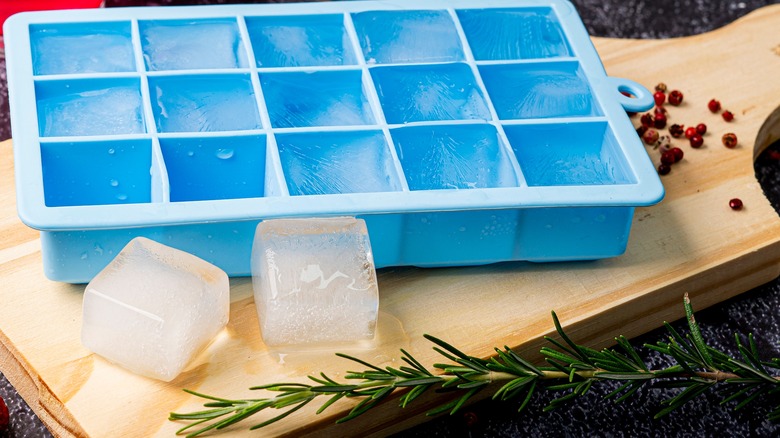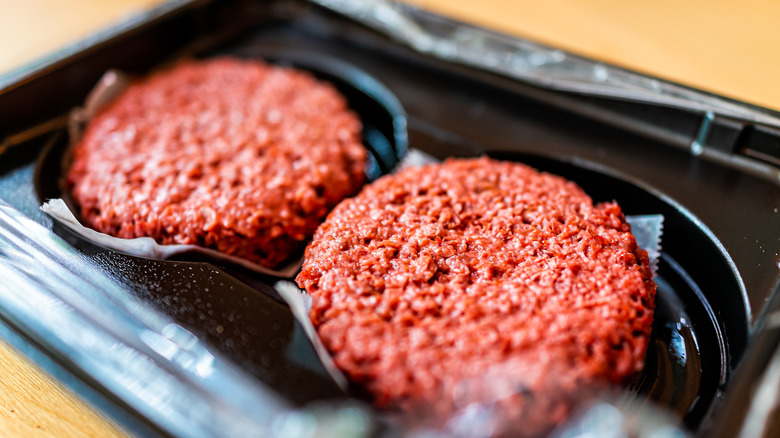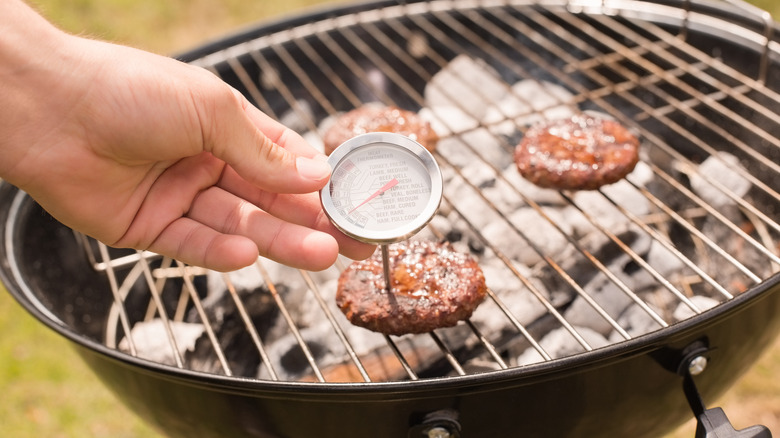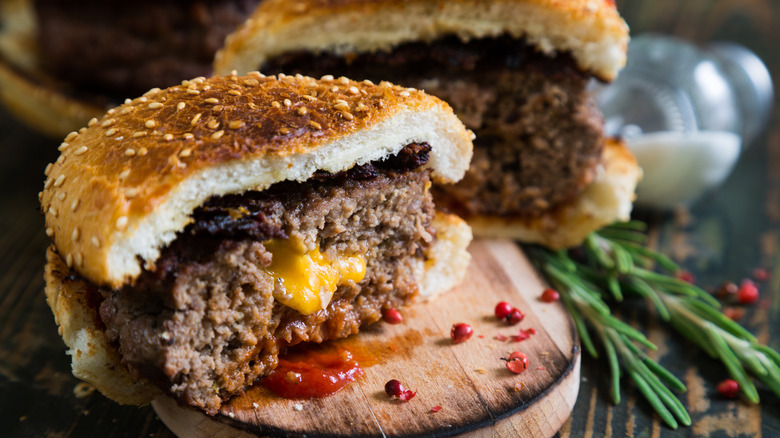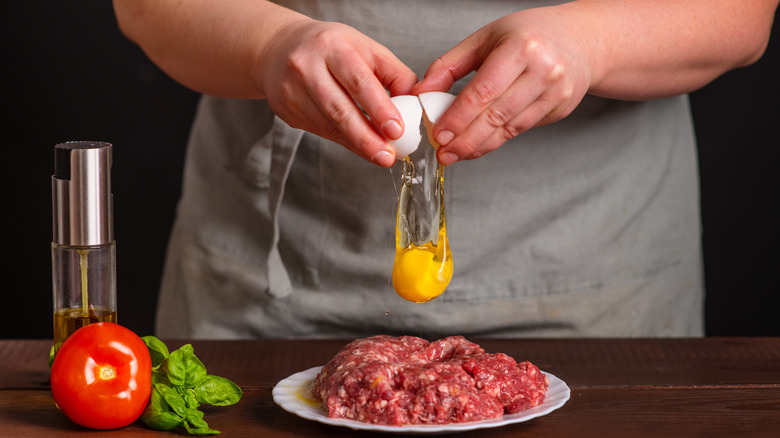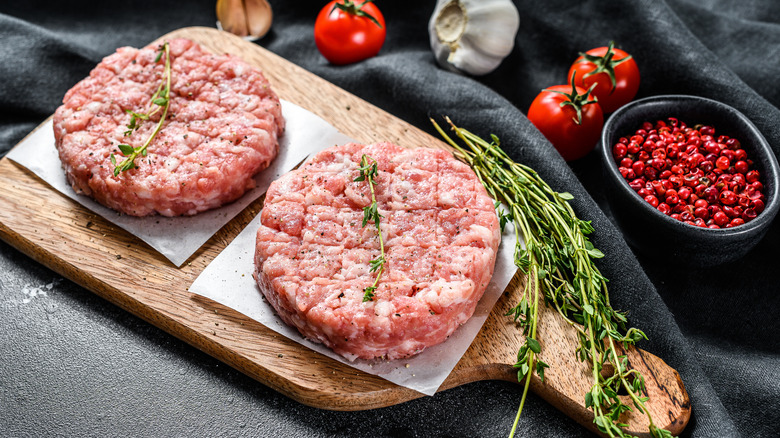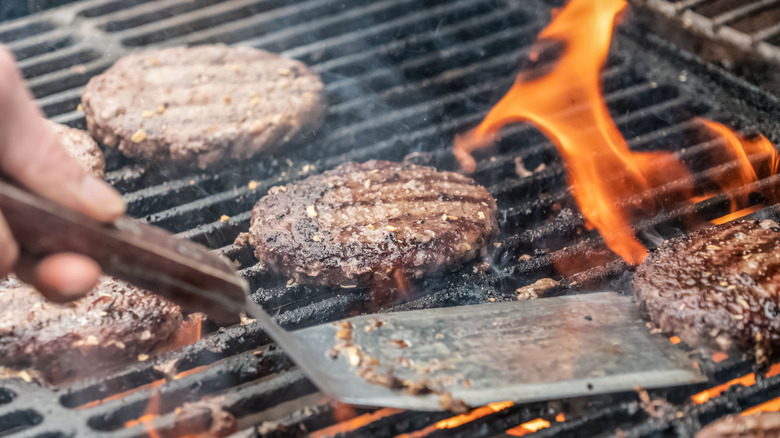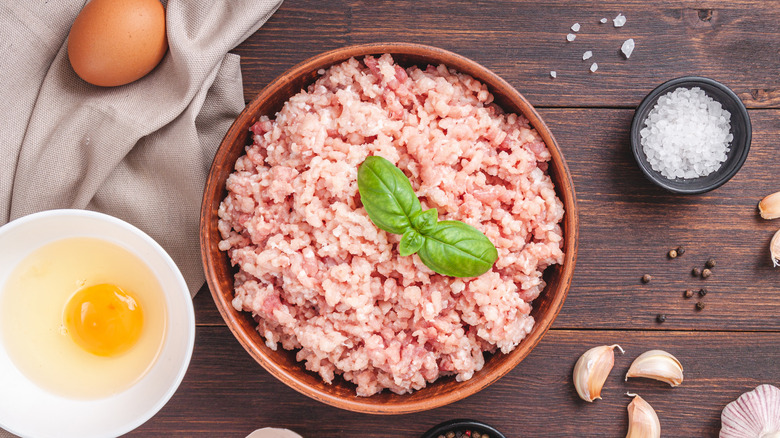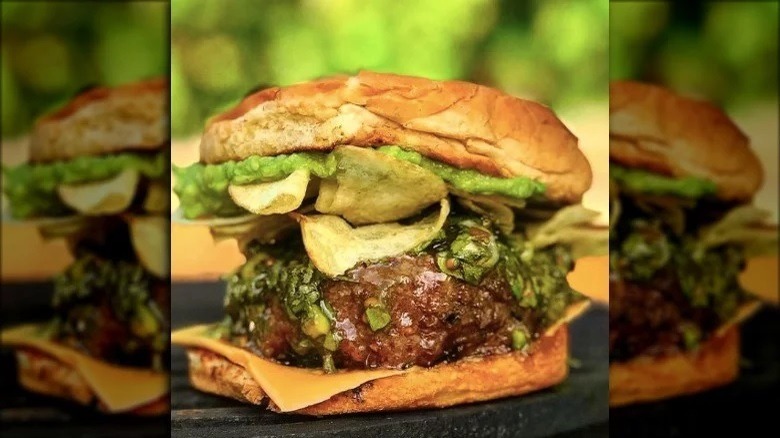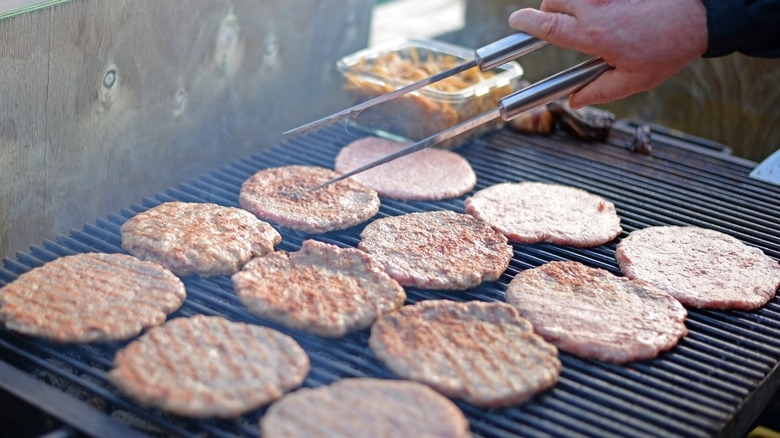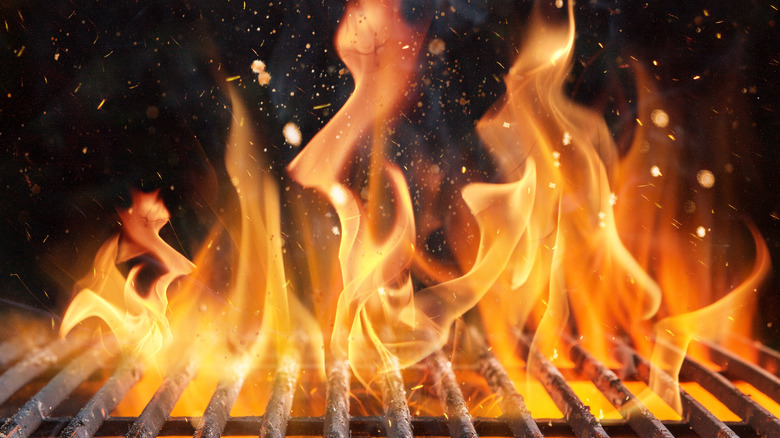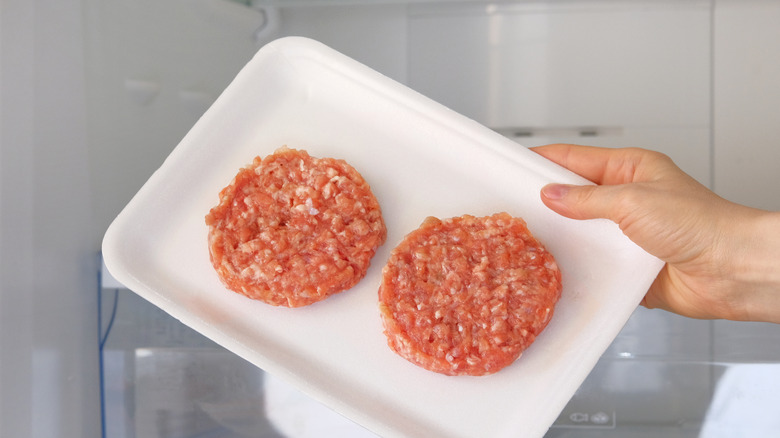20 Tips You Need For Grilling The Ultimate Burgers This Summer
Summer is for lazy days at the lake, cooling down in the pool, and our favorite — barbecuing in the backyard. But there's just something extra special about the succulent taste of a juicy burger along with the assorted toppings and condiments you managed to fit on the bun. Grilling burgers to perfection can be difficult to master if you're first starting, but any expert can tell you that the perfect patty takes time and patience. Even before you get those flames going, there are steps that you need to take to ensure your burger is cooked right.
Lucky for you, we've researched how to shape, season, and grill your ideal burger — whether it's made of beef, turkey, chicken, or plants. With some time and a couple of bags of charcoal (or a propane tank), we're sure you'll be able to fine-tune the techniques needed to grill a dreamy burger just in time for summer.
Dimple the burger to help it keep its shape
There is a very exact science behind shaping your burger. Specifically, you have to know two important things about your patties: The first is that they will shrink as they cook, so it's better to have a burger that is a bit larger than the bun. The other is that when the meat cooks, it tends to puff up in the middle — which will further shrink the size of your burger. So instead of just pressing a normal patty disc, you should use a different shaping technique for the perfect burger.
Use a spoon or your fingers to press a small dimple on both sides of the burger; this will help it cook more evenly. Avoid the urge to press down on your burger as you're grilling it, too, because this will cause it to release too much of its juices.
Use a ruler to perfectly pre-portion burgers
How do you get burgers that are the same shape and size every time — let alone ones kept in the freezer? The easiest way to pre-portion burger patties for the grill is to use a ruler or a chopstick. Start by placing a container of ground beef into a freezer bag, flattening it out evenly, and spreading it into all the corners.
After sealing the bag, use the ruler or the chopstick to press a grid pattern into the meat. Then, when you're ready to remove the meat from the freezer, you can easily break off the number of squares you need to thaw for your barbecue, and you'll be all set to shape, sear, and enjoy your patties.
Avoid overhandling the meat to prevent dryness
Do you notice your grilled burgers are always dry? You might be stumped if you've already troubleshot the obvious factors, like not having enough fat, grilling your burger for too long, and grilling on too high of a heat. One of the reasons your burger isn't juicy may be that you're handling it too much with your hands before putting it on the grill. You might not even be aware of how much you're overmixing your meat when adding your seasonings.
Realistically, you want to mix the spices to incorporate them and not much more. When you go to shape your burger, try to be extra gentle and avoid pressing your patties into molds or shapes. Use just your fingertips and move quickly to prevent a dry, tough burger.
For maximum, roll your pre-cooked patty in a seasoning blend
It's fair to say that chef Gordon Ramsay knows one or two things about burgers. Ramsay's top tip for perfectly seasoned burgers is to roll all sides of the patty in seasoning before plopping it on the grill. The "Hell's Kitchen" star also recommends adding even more seasoning to the burger after it's hit the bun.
Ramsey starts his burgers with a blend of brisket, chuck, and ground beef seasoned and shaped the night before he cooks them. He believes that this trick helps keep the burger together on the grill. For an extra dose of flavor, the chef also brushes his burgers with a butter coating while grilling. While a plain tab will do, he also recommends trying an infused butter for even more flavor.
Wet your hands when handling meat to prevent it from tensing up
Touching raw meat likely isn't anyone's definition of a fun time. Does anyone like having raw meat stuck to their hands? But there's an easy solution to stop that from happening: Wet your hands before making burger patties to help prevent the meat from sticking.
Ground meat clings to your hands because of the myosin protein — which is more readily broken down in warm conditions. So dip your hands in cold water before shaping your burgers to help slow down this reaction. And if you plan on including any mix-ins with your burgers, try adding them into the meat before you grind it to prevent dissolving the myosin. You'll be rewarded with a juicy burger instead of a dry one.
Use soda to upgrade the flavor of your burgers
It's likely you've reached for a cold bottle of Coca-Cola to wash down your burger, but you've probably never considered adding the fizzy liquid to your burger before. It turns out that soda is actually the secret ingredient that will change your burgers forever. It creates a caramelization that adds a newfound sweetness to your burgers, as well as moisture that adding plain sugar wouldn't provide.
You'll want to add ¼ cup of cola per pound or 1½ pounds of meat. If you want to amp up your cola flavor, you can also make it into a barbecue sauce by mixing it with ketchup, Worcestershire sauce, and your favorite seasonings. And the best part? You'll probably have a couple of swigs in the bottle left to drink.
Only salt your burger after you're done cooking it
One of the things you should never do when cooking hamburgers is add salt too early in the cooking process. Salt speeds up the breakdown of the myosin protein in the meat, which in turn causes it to be more sticky. A burger with a lot of myosin activity will resemble a hockey puck: firm in texture and without crevasses. Although this burger might appear picture-perfect at first glance, it won't have the same bouncy and juicy texture that you're looking for.
Resist the temptation to add salt to your burger as you shape it or while waiting to cook it on the grill. Instead, sprinkle a touch of salt on your patty once it's on the grill for the best flavor and texture.
Rest your burger after cooking
You've gone through the arduous process of shaping your patty and grilling your burger. Now the time comes for you to dive in and take a bite. But not so fast. Patience is a virtue when it comes to grilling burgers. It is necessary to let the burgers rest after cooking because this time allows the juices to circulate throughout the burger and keep it moist.
While a burger may not require the same rest time as a steak or a more substantial cut of meat, it will need a short amount of time to finish cooking through, just like any cut of meat. After you've finished grilling your burgers, you should transfer them to a wire rack with a sheet pan underneath and cover them with aluminum foil. Rest the burgers for about five to 10 minutes and they'll be ready to eat.
Use an ice cube to retain your burger's moisture
Many moisture-enhancing ingredients used in burger recipes alter the fundamental flavor of the burger. But the one ingredient that you can use to help improve the texture of your patty without changing the taste can be found in your freezer.
You should put an ice cube in your burger patty to help it maintain moisture as you grill it. Start by enveloping the ice cube with the meat; you'll need a thick patty for this trick because if the burger is too thin, the ice cube will just fall out and leave the burger deformed. You also have to be very deliberate with the temperature you cook your burger; if you cook it too low, the ice cube won't melt, and the inside of the burger will be cold.
Use the right fat ratio
If you're making a burger, you'll always want to start out on the right foot with the perfect blend of meat. Everyone has their own plan for making burgers — some people pick up ground meat at their local grocery store, while others come up with their own signature blend for the butcher to handle or to grind at home. No matter where you get your meat, you should always make sure to choose the best ground beef for burgers and stick with a solid fat ratio.
Chuck is usually a go-to burger option because it contains 80% lean meat and 20% fat (80/20). Even using meat that is 2% leaner can lead to a dry patty, a cut that is too fatty tends to fall apart on the grill and has a more gristly texture.
Use a thermometer to determine the temperature of your meat
Rare? Medium rare? Well done? You'll need to keep a meat thermometer handy if you want to make sure your burger is cooked to your exact specifications. A thermometer is the only way to determine the doneness of your meat — and it's the key to making perfect burgers every time.
Rare burgers reach an internal temperature of 125 degrees Fahrenheit, with a five-degree temperature increase for every interval after that. Medium rare burgers are finished at around 130 degrees Fahrenheit, while medium burgers are finished at 135 to 140 degrees Fahrenheit. These temperatures apply only to beef burgers. Turkey burgers and chicken burgers are finished cooking at 165 degrees Fahrenheit and should never be cooked any less than well done. If you're preparing plant-based burgers, cook those patties according to the directions on the package.
Use a beer can to form your stuffed burgers
Have you ever had a stuffed burger before? These game-changing patties can be filled with cheese, peppers, onions, or anything you can think of. The key kitchen tool to getting the perfect stuffed burgers is a beer (or soda) can.
To use this burger-making hack, you want to start with a half pound of minced meat (beef, chicken, turkey, or plant-based are all viable options) molded around the bottom of a beer can. Next, add your desired stuffing to the "bowl" created by the beer can. You can also use this hack with a beer bottle to make smaller slider sliders. Once you've sealed your burger, place it over indirect heat on the grill, or go a step further and wrap the entire patty in bacon.
Use an egg yolk to help hold your burger patty together
One of the most disheartening experiences of making a burger is having it fall part when it hits the grates. There are a few reasons this could happen including the wrong type of meat or not having the proper fat ratio. To help increase binding potential along with more flavor to his recipe, Gordon Ramsay adds an egg yolk to his burger patty.
Although adding an egg to the ground meat may seem like a better fit for a meatball or a meatloaf recipe, burgers can benefit significantly from the fatty yolk. (Ramsay recommends using one yolk per pound of ground beef.) While the egg white tends to dry out the moisture in ground beef, the yolk retains it, resulting in a moister, stickier patty.
Make a test patty to evaluate your seasonings
How would you know if you're under- or over-seasoning your burgers without tasting them? Food personality Rachael Ray makes a tiny patty before cooking a batch of burgers to test the flavor of her patty. Since you can't take a bite out of raw meat, this technique allows you to assess how well you seasoned your burgers without re-making a batch of patties.
Ray notes that your micro burger doesn't have to be that large; the size of a quarter will do. Once it's formed, she cooks the patty just under 30 seconds in a skillet to assess that she has enough seasonings and flavor. That way, she can readjust the seasoning and make the flavorful burger patties of her dreams.
Only flip your burgers once
Once your burgers have finally made it to the grill, you might be tempted to flip them several times during the cooking process. But the crucial reason why you should only flip your burgers once is that moving them around often will cause the meat to dry out more. Instead, your burger should be about three-quarters of the way cooked on one side before the patty is flipped over. In addition, prodding and touching the burger as its cooking can cause more leakage. So lay down your spatulas and lay low as your burger finishes cooking.
There aren't any exact visual cues that a burger is done cooking, but when you touch the patty with your spatula, it should come off the grill easily. You may also notice some fat oozing from the burger or light crisping on the outside of the patty.
Use Greek yogurt to keep your chicken burgers moist
Chicken burgers may be popular because they are considered "healthier" than beef, but their leanness can be detrimental to their texture and flavor. The ingredient that will change your chicken burgers forever and make them much moister is Greek yogurt. Adding Greek yogurt to your minced chicken helps incorporate some of the fat back into the meat without the gristle. You'll need about ⅓ cup of Greek yogurt for each pound of chicken, along with breadcrumbs and tons of seasoning (since chicken tends to be a bit bland).
You may also have to take extra steps to ensure you don't dry the chicken. Take special care not to touch the meat too much when forming the burgers, and only flip them once on the grill to reduce the amount of moisture lost.
Put the cheese on the bottom of the bun to prevent it from getting soggy
One of the worst parts of the cheeseburger experience is having a soggy bun. Your hands get covered in grease, pieces of the bun start to fall off, and your burger becomes slightly messier than you ever intended. Thankfully, Sunny Anderson's cheeseburger hack will help to ensure your bun remains sturdy — and so much more.
"The Kitchen" star recommends everyone put the cheese on the bottom of their burger rather than the top. This prevents the juices from seeping into the bun — plus, it gives more room for adding accouterments to the top of the burger. Anderson prefers the unorthodox combo of chips and guacamole on her burgers but she encourages her fans to get creative with their toppings.
Sear your burgers before grilling them
Everyone wants a burger with a decadent crisp outside and soft, juicy inside. One of the easiest ways to get the perfect sear on your burger is to take an extra surprising burger grilling step: sear your patties in a pan before transferring them over to the grill. James Beard Award-winning chef Jamie Bissonnette recommends evenly searing the burger on both sides and preventing the flare-ups caused by an uncontrolled grill. Then, once the burger has developed a crusty sear on the outside, it can be moved to the grill to finish cooking.
If you're skipping the sear step, you should cook burgers on high heat on the grill for the same effect. However, this method is not as reliable since you'll have less control over flare-ups.
Make sure your grill is hot enough before you start grilling
One of the biggest mistakes any burger novice makes is not adequately preheating their grill before starting. If you neglect to crank up the heat in advance, you'll leave yourself with more opportunities for the ground meat to stick to the grates, and your burger may not develop the signature crust you desire.
The temperature for an adequately heated grill is around 500 degrees Fahrenheit which you can gauge using an infrared thermometer. At this high of heat, all of your charcoal should be gray in color. You can also conduct a feel test on your grill; you should not be able to hold your hand a couple of inches above the grill for more than a few seconds.
Keep your burgers chilled before cooking
There are a lot of questions out there around what temperature you should cook your burgers from. Some meats, like steak, can only be cooked from room temperature. But it pays off to chill your burger patties before cooking because cold patties tend to keep a more uniform shape. This is because fat renders at warm temperatures, which can cause the burger to become misshapen. Room-temperature burgers also have more water to evaporate off as the burger cooks, which can prolong the cooking time and mess with your sear.
From a food safety perspective, leaving your burgers out can also cause issues with foodborne illness. According to the USDA, Ground beef should never be left out at room temperature for more than two hours, and burgers should always be cooked all the way through rather than only partially grilled and chilled.
Static Media owns and operates Tasting Table, Mashed, and The Daily Meal.
